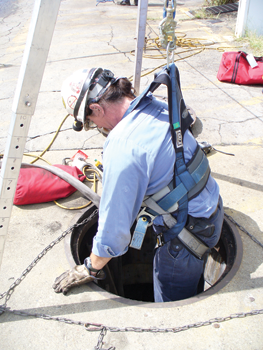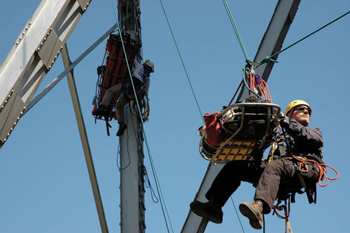Alan M. Petrillo
Rope rescue can take many forms, from high-angle rescue to confined space, low-angle, swiftwater, and even self-rescue. Although techniques differ for the various types of rope rescue-high-angle might be off a cliff, bridge, building, or from the tip of an aerial platform compared with the tactics used in confined space or the strategies and different gear in swiftwater rescue-the basic equipment load and types of specialized hardware needed to pluck people from precarious places is similar across the disciplines.
Using the Right Tool
Matt Hunt, rescue safety market manager for Sterling Rope Company, says his company offers products suited for the various fields of rope rescue. “The key is focusing on using the right tool for the job or application,” Hunt says, “and to use the tool designed for that task.”
For instance, he says for standard high-angle rescue, such as rappelling off the side of a building or other structure, many fire department rescue teams choose to use either Sterling’s SuperStatic or high tenacity polyester (HTP) Static, typically 11 millimeters (mm) thick. “The HTP has a much lower stretch to it,” Hunt says, “only one to two percent elongation, compared to three to four percent elongation of nylon at a 300 pound load.”
Sterling Rope stocks HTP and SuperStatic rope in 150-, 200-, 300-, and 600-foot lengths, although it will accommodate special length orders. “Most fire departments use ropes in 200- and 300-foot applications,” Hunt observes.
John Evans, marketing director for Petzl, says his company has a static rope made to its specifications by Samson Rope that is used across various rope rescue disciplines. “It’s typical for heavy rescue teams to use our rope for high-angle rescue, embankment rescue, and confined space,” Evans says. “It’s rated for lowering a two-person load, such as a litter and an attendant, down from a structure or pulling them up an embankment or from a confined space.”
Evans notes that Petzl’s 11-mm ropes are typically used for rappelling, while its 13-mm-diameter ropes are usually recommended for a two-person load.
 |
| (1) Petzl makes a self-rescue rope kit for firefighters, the EXO personal escape system, consisting of a multipurpose anchor hook, a self-braking descender, a carabiner, and 50 feet of 7.5-mm Technora® rope. (Photo courtesy of Petzl.) |
Versatility
Robert Womer, sales associate and instructor at Rock-N-Rescue, says that very often fire departments use the same type of equipment for mountain rescue as they do for confined space situations. “The equipment is very versatile,” Womer says, “whether it’s the ropes or the hardware, it all gets used in the many different disciplines that rescuers face when working with ropes.”
Besides manufacturing its own brands of equipment under its name, Rock-N-Rescue also distributes other brands of the same and similar rope and hardware products.
Hunt concurs that the same type of the equipment used in high-angle rescue is also used in confined space and low-angle rescue. “National Fire Protection Standard (NFPA) 1983, Standard on Life Safety Rope and Equipment for Emergency Services, has two different categories of ropes: one for general use and the other for technical rescue,” he says. “For general use, it specifies a half-inch rope with a 9,000-pound breaking strength, and 7/16-inch (11 mm) with a minimum of 7,000-pound breaking strength for technical use.”
But, some hardware is different for confined space, Hunt notes. “With low-angle rescue and confined space rescue, fire departments usually use aluminum carabiners instead of steel,” he says. “They also use lighter pulleys for setting up their hauling systems. The main issues with confined space are air quality and fitting the rescuer into the access space.”
For swiftwater rescues, Hunt notes the most common application is a throw bag-usually 75 feet of water rescue rope in a bag about the size of a football. “The rope is often tied to a grommet in the bottom of the bag and the bag is thrown out about 40 feet or so to the person to be rescued,” Hunt says. “The weight of the rope carries the bag to the victim, who then grabs on and is hauled to safety.”
Sterling Rope makes a high-strength water rescue rope with a Dyneema® core and a polypropylene sheath that allows it to float.
Other types of ropes are used in setting up guide lines across a river or other waterway to hold a boat in position to rescue someone coming down the waterway and also for tensioning and haul systems to help move a load back and forth across the waterway.
Evans notes that harnesses and helmets are important parts of the rope rescue inventory. “An important piece of gear is our Vertex helmet, which comes in various models, some of which have ventilation systems on them that are popular with firefighters,” he says. “We also have helmets rated for electrical protection.”
Petzl also sells the Navajo Bod harness, an NFPA 1983-compliant full body harness that is often used in high-angle rescue and confined space situations.
 |
| (2) Confined space presents additional challenges in rope rescue work, especially because of the nature of the narrow, restricted places where firefighters must operate. (Photo courtesy of Rock-N-Rescue.) |
Self-Rescue
Rope rescue is paramount in the area of self-rescue, where firefighters have several options available to them as bailout kits. Hunt says his company has been kept busy making personal escape kits for firefighters. “We worked with FDNY to develop the rope used in its personal escape system,” Hunt says. “The interaction of the rope and the hardware is important, so we then developed the F4 descent control device.”
The F4 is compliant with NFPA 1983 and also as a personal escape system when used with Sterling FireTech rope and a Crosby hook, which is the system FDNY uses. The rope is prerigged by threading it through the F4’s four holes, then it passes through a release handle, which when squeezed releases the rope to allow horizontal movement or descent. Although the F4 is autolocking to allow a hands-free bailout, the firefighter still must use both hands to operate the device-one hand on the F4 and the brake hand on the free end of the rope to control the speed of descent.
Evans notes that Petzl offers the EXO personal escape system for use with various harness configurations. The EXO includes a multipurpose anchor hook, a self-braking descender, a carabiner, and 50 feet of 7.5-mm Technora® rope that resists flame, high temperature, and abrasion and is cut-resistant. The entire system is contained in a Nomex® bag that’s worn on the belt. “It’s important to have the hook easily available, so our pouch has a dedicated slot for the hook that keeps it ready to use and prevents it from getting tangled,” he says. “You don’t want to put the hook in the pocket of your bunker pants because you want it available for quick access.”
 |
| (3) Sterling Rope Co. makes both SuperStatic and HTP Static ropes in 11-millimeter thicknesses for rappelling and high-angle rescue work. (Photo courtesy of Sterling Rope Co.) |
ALAN M. PETRILLO is a Tucson, Arizona-based freelance writer and is a member of the Fire Apparatus & Emergency Equipment editorial advisory board. He served 22 years with the Verdoy (NY) Fire Department, including in the position of chief.

